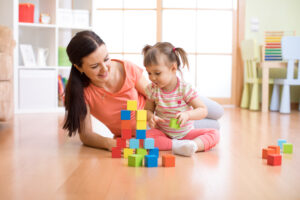

Self-Regulation in Young Children
You may be surprised to learn that the process by which children learn to regulate their body, emotions and behaviors starts from the minute they
From the moment your baby is born many of the things you are naturally doing as a caregiver such as smiling at your baby, rocking your baby, and trying to detect why they are crying are laying important foundations for your child’s self-regulation. Helping your child develop their ability to self-soothe and self-regulate is not only important for them managing their emotions and behaviors but is also essential for other areas of their development including their physical health, learning and social relationships. The more ease and speed by which your child can calm in the face of stress, the more their body is able to devote precious resources to other important physical and mental processes. Dr. Shanker, a leading expert on self-regulation, identified five steps caregivers can take to support their child’s developing self-regulation:
Each child varies in their self-regulation abilities and response to stress in their environment. As a caregiver you have the amazing opportunity to learn your child’s specific stressors and stress cues and promote your child’s self-regulation by responding with warmth and sensitivity. By following Dr. Shanker’s five steps you are helping your child to learn to self-soothe and supporting your child as a whole child by fostering their physical, behavioral and emotional well-being.


You may be surprised to learn that the process by which children learn to regulate their body, emotions and behaviors starts from the minute they


The Dial Up and Dial Down Model “The better I self-regulate as a parent, the better my child will self-regulate. The better my child self-regulates,


An excerpt from the behind-the-scenes interview with Adele Diamond, Ph.D. from the 2016 Simms/Mann Institute Think Tank.



As parents, we get so much feedback about what we can do to enhance our baby’s development. Sometimes, it can be difficult to remember one


Children thrive when they are provided with a predictable, structured environment. Routines provide a sense of safety and security, as well as foster healthy emotional and


Just think of how much time babies spend in routines of one kind or another: sleeping, bathing, feeding, and diaper changing, not to mention dressing,


An excerpt from a behind-the-scenes interview with Dr. Kathy Hirsh-Pasek at the 2018 Simms/Mann Institute Think Tank



As parents, we get so much feedback about what we can do to enhance our baby’s development. Sometimes, it can be difficult to remember one
| Cookie | Duración | Descripción |
|---|---|---|
| __stripe_mid | 1 year | Stripe sets this cookie cookie to process payments. |
| __stripe_sid | 30 minutes | Stripe sets this cookie cookie to process payments. |
| cookielawinfo-checkbox-advertisement | 1 year | Set by the GDPR Cookie Consent plugin, this cookie is used to record the user consent for the cookies in the "Advertisement" category . |
| cookielawinfo-checkbox-analytics | 11 months | This cookie is set by GDPR Cookie Consent plugin. The cookie is used to store the user consent for the cookies in the category "Analytics". |
| cookielawinfo-checkbox-functional | 11 months | The cookie is set by GDPR cookie consent to record the user consent for the cookies in the category "Functional". |
| cookielawinfo-checkbox-necessary | 11 months | This cookie is set by GDPR Cookie Consent plugin. The cookies is used to store the user consent for the cookies in the category "Necessary". |
| cookielawinfo-checkbox-others | 11 months | This cookie is set by GDPR Cookie Consent plugin. The cookie is used to store the user consent for the cookies in the category "Other. |
| cookielawinfo-checkbox-performance | 11 months | This cookie is set by GDPR Cookie Consent plugin. The cookie is used to store the user consent for the cookies in the category "Performance". |
| CookieLawInfoConsent | 1 year | Records the default button state of the corresponding category & the status of CCPA. It works only in coordination with the primary cookie. |
| elementor | never | This cookie is used by the website's WordPress theme. It allows the website owner to implement or change the website's content in real-time. |
| viewed_cookie_policy | 11 months | The cookie is set by the GDPR Cookie Consent plugin and is used to store whether or not user has consented to the use of cookies. It does not store any personal data. |
| Cookie | Duración | Descripción |
|---|---|---|
| mailchimp_landing_site | 1 month | The cookie is set by MailChimp to record which page the user first visited. |
| Cookie | Duración | Descripción |
|---|---|---|
| _ga | 2 years | The _ga cookie, installed by Google Analytics, calculates visitor, session and campaign data and also keeps track of site usage for the site's analytics report. The cookie stores information anonymously and assigns a randomly generated number to recognize unique visitors. |
| _gat_gtag_UA_46801669_2 | 1 minute | Set by Google to distinguish users. |
| _gid | 1 day | Installed by Google Analytics, _gid cookie stores information on how visitors use a website, while also creating an analytics report of the website's performance. Some of the data that are collected include the number of visitors, their source, and the pages they visit anonymously. |
| tk_lr | 1 year | The tk_lr is a referral cookie set by the JetPack plugin on sites using WooCommerce, which analyzes referrer behaviour for Jetpack. |
| tk_or | 5 years | The tk_or is a referral cookie set by the JetPack plugin on sites using WooCommerce, which analyzes referrer behaviour for Jetpack. |
| tk_r3d | 3 days | JetPack installs this cookie to collect internal metrics for user activity and in turn improve user experience. |
| tk_tc | session | JetPack sets this cookie to record details on how user's use the website. |
| Cookie | Duración | Descripción |
|---|---|---|
| cookies.js | session | No description available. |
| m | 2 years | No description available. |